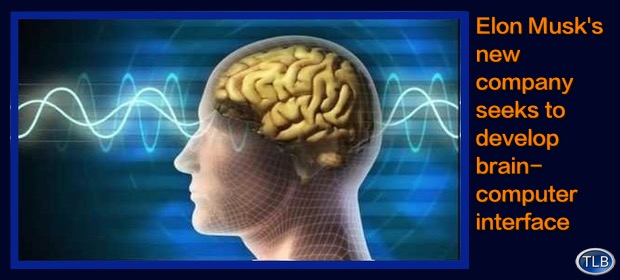
Elon Musk Launches Company To Hook Up People To Computers
TYLER DURDEN
In case revolutionizing the transportation and energy industries while colonizing Mars wasn’t enough of a challenge for Elon Musk (or perhaps taxpayer subsidies for Musk’s ventures in those fields have dried up), in his latest venture the billionaire entrepreneur now “wants to merge computers with human brains to help people keep up with machines.” Specifically, the WSJ has uncovered that Musk has launched another company called Neuralink, which is pursuing what Musk calls “neural lace” technology, which is shorthand for a brain-computer interface and consists of implanting tiny brain electrodes that will one day be able upload and download thoughts.
Think the 2014 Johnny Depp movie Transcendence.
Musk has taken an active role setting up the California-based company and may play a significant leadership role, according to people briefed on Neuralink’s plans, a bold step for a father of five who  already runs two technologically complex businesses. While Musk did not comment on the story, Max Hodak, who said he is a “member of the founding team,” confirmed not only the company’s existence but also Musk’s involvement. “He described the company as “embryonic” and said plans are still in flux but declined to provide additional details. Mr. Hodak previously founded Transcriptic, a startup that provides robotic lab services accessible over the internet.”
already runs two technologically complex businesses. While Musk did not comment on the story, Max Hodak, who said he is a “member of the founding team,” confirmed not only the company’s existence but also Musk’s involvement. “He described the company as “embryonic” and said plans are still in flux but declined to provide additional details. Mr. Hodak previously founded Transcriptic, a startup that provides robotic lab services accessible over the internet.”
Investors in Musk’s current ventures may not be particularly pleased to learn that the inventor has found yet another distraction from his already ambitious, and in the case of Tesla, lofty and overvalued goals. Currently, the 45-year-old Paypal founder splits his time between Tesla, which is under pressure to deliver its $35,000 sedan on time, and SpaceX, which aims to launch a satellite-internet business and a rocket that can bring humans to Mars. He is also pushing development of a super high-speed train called Hyperloop. And, the WSJ notes, somewhere in his packed schedule, he has found time to start a neuroscience company that plans to develop cranial computers, most likely to treat intractable brain diseases first, but later to help humanity avoid subjugation at the hands of intelligent machines.
Musk had previously hinted at the existence of Neuralink a few times over the last six months or so. As the Verge notes, recently Musk told a crowd in Dubai, “Over time I think we will probably see a closer merger of biological intelligence and digital intelligence.” He added that “it’s mostly about the bandwidth, the speed of the connection between your brain and the digital version of yourself, particularly output.” On Twitter, Musk has responded to inquiring fans about his progress on the so-called “neural lace,” which is sci-fi shorthand for a brain-computer interface humans could use to improve themselves.
“If you assume any rate of advancement in [artificial intelligence], we will be left behind by a lot,” he said at a conference last June. The solution he proposed was a “direct cortical interface”—essentially a layer of artificial intelligence inside the brain—that could enable humans to reach higher levels of function.
Mr. Musk has discussed financing Neuralink primarily himself, including with capital borrowed against equity in his other companies, according to a person briefed on the plans.Neuralink has also discussed a possible investment from Founders Fund, the venture firm started by Peter Thiel, with whom Mr. Musk co-founded payments company PayPal, according to people familiar with the matter.
For now, the types of brain-computer interfaces contemplated by Neuralink exist only in science fiction. In the medical realm, electrode arrays and other implants have been used to help ameliorate the effects of Parkinson’s, epilepsy, and other neurodegenerative diseases. However, it goes without saying that very few people have complex implants placed inside their skulls, while the number of patients with very basic stimulating devices number only in the tens of thousands. This is partly because it is incredibly dangerous and invasive to operate on the human brain, and only those who have exhausted every other medical option choose to undergo such surgery as a last resort.
Still, as the Verge adds, this has not stopped a surge in Silicon Valley interest from tech industry futurists who are interested in accelerating the advancement of these types of far-off ideas. Kernel, a startup created by Braintree co-founder Bryan Johnson, is funding medical research out of the University of Southern California to try and enhance human cognition. With more than $100 million of Johnson’s own money — the entrepreneur sold Braintree to PayPal for around $800 million in 2013 — Kernel and its growing team of neuroscientists and software engineers are working toward reversing the effects of neurodegenerative diseases and, eventually, making our brains faster and smarter and more wired.
“We know if we put a chip in the brain and release electrical signals, that we can ameliorate symptoms of Parkinson’s,” Johnson told The Verge in an interview late last year. (Johnson also confirmed Musk’s involvement with Neuralink.) “This has been done for spinal cord pain, obesity, anorexia… what hasn’t been done is the reading and writing of neural code.” Johnson says Kernel’s goal is to “work with the brain the same way we work with other complex biological systems like biology and genetics.”
The Verge notes that Kernel is upfront about the years of medical research necessary to better understand the human brain and pioneer new surgery techniques, software methods, and implant devices that could make a consumer brain-computer interface a reality. The Wall Street Journal says Neuralink was founded as a medical research company in California last July, which bolsters the idea that Musk will follow a similar route as Johnson and Kernel.
Meanwhile, Musk appears to be aggressively growing the new venture.
In recent weeks, Neuralink has reportedly hired leading academics in the field, according to another person familiar with the matter. They include Vanessa Tolosa, an engineer at the Lawrence Livermore National Laboratory and an expert in flexible electrodes; Philip Sabes, a professor at the University of California in San Francisco, who studies how the brain controls movement; and Timothy Gardner, a professor at Boston University who is known for implanting tiny electrodes in the brains of finches to study how the birds sing.
It is unclear what sorts of products Neuralink might create, but people who have had discussions with the company describe a strategy similar to SpaceX and Tesla, where Mr. Musk developed new rocket and electric-car technologies, proved they work, and is now using them to pursue more ambitious projects. The company’s first products could be advanced implants to treat intractable brain disorders like epilepsy or major depression, a market worth billions of dollars. Such implants would build on simpler electrodes already used to treat brain disorders like Parkinson’s disease.
If Neuralink can prove the safety and efficacy of its technology and receive government approval, perhaps it then could move on to cosmetic brain surgeries to enhance cognitive function, these people say. Mr. Musk alluded to this possibility in his comments last June, describing how humans struggle to process and generate information as quickly as they absorb it.
Kernel’s Johnson said he has spoken Mr. Musk and that both companies want to build better neural interfaces, first to attack big diseases, and then to expand human potential.
They are not alone: Facebook has posted job ads for “brain-computer interface engineers” and other neuroscientists at its new secret projects division. And the Defense Advanced Research Projects Agency is investing $60 million over four years to develop implantable neural interface technology.
Of course, loading up one’s consciousness into a computer, which is the ultimate goal of such “neural lace” ventures, will not happen tomorrow. The hurdles involved in developing these devices are immense. Neuroscience researchers say we have very limited understanding about how the neurons in the human brain communicate, and our methods for collecting data on those neurons is rudimentary. Then there’s the idea of people volunteering to have electronics placed inside their heads.
“People are only going to be amenable to the idea [of an implant] if they have a very serious medical condition they might get help with,” Blake Richards, a neuroscientist and assistant professor and the University of Toronto, told The Verge in an interview earlier this year. “Most healthy individuals are uncomfortable with the idea of having a doctor crack open their skull.”
At the end of the day, perhaps the latest Musk venture is nothing more than a vanity project: invest enough money into a project which, if successful, will allow if not Musk, then his mind, to live forever. We wish him all the best in this latest endeavor, but wonder how much of this particular pet project is funded directly and indirectly by taxpayers.
Meanwhile, questions over Musk’s own, carbon-based “bandwidth” will only grow. Tesla is building the largest battery factory on the planet to supply its forthcoming Model 3 electric vehicle, and it will need to produce hundreds of thousands of cars to meet its goal and justify its lofty market capitalization, which is approaching that of Ford. SpaceX has struggled to launch rockets fast enough to send satellites into orbit for its customers. Ultimately it wants to launch an internet-access business powered by more than 4,000 low-earth orbiting satellites, ferry space tourists to the moon and then bring astronauts to Mars. An unexpected project to enable interfacing with computers and ultimately, immortality, may not be what Musk needs to win over a rising tide of skeptics.
************
ER recommends other articles by Zerohedge




